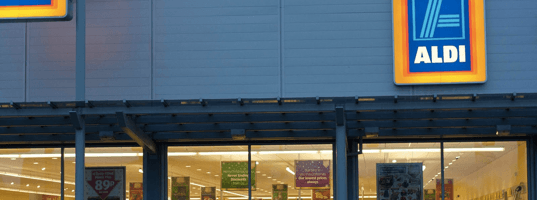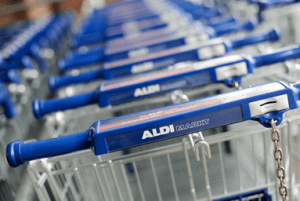Aldi: no frills grocery shopping

Driving down costs to lower the price of your weekly shop
Aldi is a German deep-discount grocery store that has disrupted the market through its relentless drive to lower prices for consumers. It now has over 4,000 stores across the United States and Europe.
Aldi’s successful business model is based on offering high quality grocery at the lowest price to cost-conscious consumers. Its products are typically 20 to 45% cheaper than those of its regular competitors.
The company is able to offer such low prices thanks to its persistent focus on lowering operating costs across the business through simplicity, consistency and responsibility.
Simple product range and limited inventory
Aldi only stocks around 1,500 staple items compared to the tens of thousands of SKUs typically stocked by regular supermarkets. This simplifies every levels of the supply chain, from purchasing to distribution, thereby keeping costs low. High sales volume per SKU also allows the company to take advantage of economies of scale in purchasing, further reducing the price for the customer.
In addition, 90% of Aldi’s products are own-brand, generating lower prices for consumers and higher margins for the company.

Aldi has a just-in-time inventory model which means that products are delivered when they are needed. This reduces the capital tied up in stock as well as lowering the cost of warehousing and associated labour costs.
Consistent design
Each Aldi store and warehouse is constructed to a similar simple design, allowing for uniform processes and systems, and ultimately lower operating costs. Complexity has also been removed from distribution and packaging: delivery vans are the same size, and pallets are standardised.
No-frills packaging
Aldi has removed many non-essential grocery store services including unpacking and arranging products. Boxes and pallets are typically used as product displays to save on labour costs associated with product handling.

Efficient checkout
Aldi has reduced the time it takes to checkout through a number of different schemes. Fruit is sold in bags so it does no longer needs to be weighed. Products have multiple barcodes reducing the time it takes to search for and scan the barcode. Customers put their purchases back into their trolley after paying and then bag them elsewhere, allowing space for the next customer to check out. This parallel processing reduces the throughput time and increases the capacity i.e., the number of customers that can be serviced by a given cashier and checkout station. Fewer tills are therefore required, and labour costs can be reduced.
Trolley rental system
Customers are required to ‘rent’ shopping trolleys by putting in a coin in order to release a trolley. The coin is then returned once the trolley is linked back up to the column of trolleys. Along with a wheel locking mechanism that is activated when trolleys are removed from the shop, this reduces the number of lost trolleys, thereby reducing the cost of replacement for Aldi. This saving can then be passed onto the customer through lower prices.
The trolley rental system also incentivises shoppers to return their trolleys to the docking station rather than leaving them lying around the shop or car park, thereby reducing the labour cost associated with managing the trolleys.

Devolved responsibility
Aldi’s workforce is well-trained and tightly disciplined. The company has adopted various aspects of the lean manufacturing principle, including a focus on continuous improvement and accountability for all employees from the shop floor up to senior management. Employees are also cross-trained: this flexibility allows the company to maintain a smaller workforce and therefore lower costs.
Building a sustainable advantage
Aldi’s highly efficient operating model is critical to its ability to offer high quality products at deeply discounted prices. This strategy has thus far served the company well, leading to global sales of €67.4bn in 2013, double-digit growth and global expansion.
Aldi will, in all likelihood, continue to reap the benefits of its low-cost model since the model appears to be sustainable over the long-term, and is difficult to replicate thanks to its reliance on a culture of continuous improvement and employee responsibility.
- http://www.nytimes.com/2011/03/30/business/30aldi.html?_r=3&src=busln
- Competitive Advantage Through Efficiency, An Aldi Case Study, businesscasestudies.co.uk
- The 4 As, Boxwood publication
- http://www.ft.com/intl/cms/s/0/be5e8d52-7ec6-11e4-b83e-00144feabdc0.html#axzz3tYsQ64aS
- www.aldiuscareers.com




As a student living in Glasgow in mid 2000s, it always frustrated me when I couldn’t find a particular brands that I like at the local Aldi. Now I understand why. It was Aldi’s conscious choice to stock limited SKUs and offered staggering amount of its own brand in order to maintain the deep discount it offered on the products. As we learnt in Marketing, store brands offer the highest margins and Aldi provided the best selection of everyday goods for customers who are price sensitive and brand agnostic.
Really enjoyed reading about Aldi’s operating model and learning about all the small things they do to reduce costs so they can pass it on the customer. One of the first things I remember from going to an Aldi was the shopping cart system which we now know from the IDEO video, is a big deal for grocery stores. It’s surprising that not many other stores have adopted it in the US like they have in Europe. One thing to add is in the US, Aldi only takes cash or debit cards (at least in the last one I was at). This is another way they make small changes to reduce prices, avoiding the extra fee to card companies like VISA or American Express.
As a child, I made many trips to Aldi with my parents, so I really enjoyed reading this! I had never really considered the intentionality of so many of these choices (e.g. leaving the items in the boxes, having customers pack their own stuff to decrease cycle time and labor cost). I’ve also noticed that at the Aldi we went to, the cashiers were always seated, which reduces the fatigue element that comes with standing cashiers. They also charged for plastic/paper bags, which I imagine helps keep costs low — Another thing that seems to not have caught on broadly in the U.S., even though it is beneficial for both cost-savings and environmental sustainability.